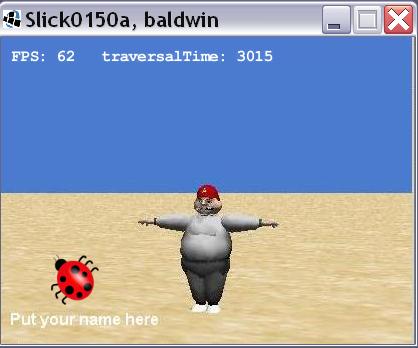| << Chapter < Page | Chapter >> Page > |
| Figure 2 . Graphic output from the earlier program. |
|---|
 |
Adding many more sprites would have been difficult
While it would have been possible to add more sprites to the animation by expanding the code used in that program, the code would havequickly gotten out of hand without the use of a sprite class and sprite objects. (To use the common jargon, that program architecture was not very scalable.)
Encapsulate complexity in a class
Basically, this program solves that problem by encapsulating many of the properties and methods that are useful for manipulating sprites into a classfrom which sprite objects can be instantiated. Most of the complexity is encapsulated in the class and thereby removed from the program that uses objectsof the class.
The scenario
This program shows a baseball coach ( Figure 1 ) being attacked by a swarm of vicious ladybug sprites. (Don't worry, we will find a way to save the coach in the next module.)
This program uses the class named Sprite01 to populate the game window with 1000 ladybug sprites in differentcolors with different sizes that fly around the game window in different directions with different speeds as shown in Figure 1 .
A complete listing of this class is provided in Listing 11 . I will not explain the entire class in detail in this module. Instead, I will provide an overview of the class and then explain various parts of theclass as I use them in this and the next two modules.
Beginning of the class named Sprite01
The beginning of the class named Sprite01 down through the constructor is shown in Listing 1 .
| Listing 1 . Beginning of the class named Sprite01. |
|---|
public class Sprite01{
Image image = null;//The sprite wears this imagefloat X = 0f;//X-Position of the sprite
float Y = 0f;//Y-Position of the spritefloat width = 0f;//Width of the sprite
float height = 0f;//Height of the spritefloat xStep = 1f;//Incremental step size in pixels - X
float yStep = 1f;//Incremental step size in pixels - Yfloat scale = 1f;//Scale factor for draw method
Color colorFilter = null;//Color filter for draw methodfloat xDirection = 1.0f;//Move to right for positivefloat yDirection = 1.0f;//Move down for positiveint life = 1;//Used to control life or death of spriteboolean exposed = false;//Used in the contagion program//Constructor
public Sprite01(Image image,//Sprite wears this imagefloat X,//Initial position
float Y,//Initial positionfloat xDirection,//Initial direction
float yDirection,//Initial directionfloat xStep,//Initial step size
float yStep,//Initial step sizefloat scale,//Scale factor for drawing
Color colorFilter)
throws SlickException {//Save incoming parameter values
this.image = image;this.X = X;
this.Y = Y;this.xDirection = xDirection;
this.yDirection = yDirection;this.xStep = xStep;
this.yStep = yStep;this.scale = scale;
this.colorFilter = colorFilter;//Compute and save width and height of imagewidth = image.getWidth();
height = image.getHeight();}//end constructor |

Notification Switch
Would you like to follow the 'Anatomy of a game engine' conversation and receive update notifications?